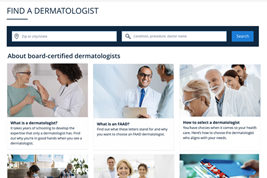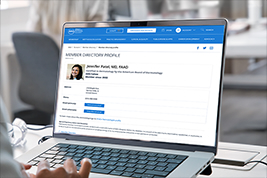Community outreach toolkit: Skin cancer screenings

What is this program?
The AAD’s Skin Cancer Check Program is an opportunity for states to promote members as the leading experts in skin cancer detection and treatment. The AAD provides a digital platform for AAD members to conduct skin check events as well as guidance on planning the event, outreach to media, and community education resources.
Why should states get involved?
This program is an opportunity for your members to give back to communities and promote the profession of dermatology and raise the visibility of your members as the first stop in skin cancer treatment.
What is the cost?
Members have access to the digital platform at no charge. It includes educational and marketing materials which are available for download.
Events
How can I/we get involved?
Find an existing event in your state or community and ask if your members to provide free skin cancer checks to attendees.
Form a workgroup or committee to champion this project within members’ practice, program, or state society and to spearhead any outreach and publicity efforts.
Is there an overview of the entire program?
Skin Cancer Check Program guidelines (PDF)
Where do I get materials?
All skin cancer check materials are free and available for download to AAD members on the digital platform.
What is the timeline for planning?
See recommendations in the Skin Cancer Screening Program guidelines (PDF).
What is the difference between a public and private skin cancer check?
Private skin checks are usually conducted for a specific organization and are only offered to employees. Public skin checks are offered to the general community.
Who can assist at the skin cancer check?
Medical personnel, including residents, well-trained physician assistants (PAs), and nurse practitioners (NPs), can check skin under the direct supervision of a dermatologist. However, an Academy member MUST serve as the skin check director and be in attendance at the screening.
When do most free skin cancer checks take place?
You can open the conversation with any organization at any time.
Skin checks are generally held between May-August. However, skin checks can take place at any time during the year. The Academy reminds the public of the importance of year-round sun protection, so hosting a skin check in the winter months is appropriate.
Where are most skin checks held?
Anywhere Wi-Fi is available! Skin checks can be held at offices, fairs, beaches, hospitals, etc. However, skin check locations for exposed skin can only be held where there is enough privacy for comfort. Full body skin checks require private rooms.
How many volunteers are needed for the skin cancer check?
Invite as many local dermatologists and their staff (residents, NPs, and PAs) as possible. Assign time slots for those individuals who agree to skin check. Note the following suggestions:
One dermatologist can usually check between 6-10 patients an hour.
Have female and male assistants available if a chaperone is requested.
Recruit assistants to help with attendee questionnaires and traffic flow.
How should the skin check room be set up?
Each exam room should include a table or two chairs, exam gowns, latex gloves or hand sanitizer, and additional lighting, if needed.
How long will I have access to attendee forms on the platform?
Members will have access to attendee forms for 6 years.
Media
How do I/we approach the media?
With any community event, it is important to publicize, engage the media, and create excitement around the event.
Reach out to community leaders to encourage their constituents to attend, especially in underserved and at-risk communities. Engage the media early in the process to encourage stories about skin cancer and provide guidance about where this free skin check is to be held. Explore the possibility of a Melanoma Monday proclamation from the mayor or having patient advocates share their stories.
Are there sample materials to help?
Sample pitch letters (PDF)
Sample radio PSA scripts (PDF)
How does the AAD promote the skin check event?
For public skin checks, the Academy will post details about the skin cancer check on its website and a toll free number, including a contact’s phone number to make an appointment, get directions, or ask questions.
Visitors looking for a free skin cancer check in their area can enter their zip code to find a skin check within a 50-mile radius.
Education
How can I continue to educate our community?
Skin cancer checks play an important role in increasing public awareness about skin cancer prevention and detection.
The AAD has ready-made tips and resources about how to educate communities about skin cancer, along with free and downloadable flyers to share in your communities.
Download these free educational resources to help others learn how to prevent and detect skin cancer, including infographics and flyers, educational materials for kids, and videos.
Fact sheets: Reinforce your message by leaving behind the AAD's skin cancer fact sheet and indoor tanning fact sheet.
Patient education: Find everything you need to educate your patients about skin conditions.
Skin cancer prevention and detection: Incorporate these tips into your presentation or hand them out at your event. You can also download the Academy’s free body mole map.
Stories/Best practices

Margaret Snyder, MD shares the story of how she got involved screening firefighters with her colleague Christine Kannler, MD.
Learn how to get started
To learn how to get started and access additional resources, contact AAD Community Outreach Programs.
 Find a Dermatologist
Find a Dermatologist
 Member directory
Member directory
 AAD Learning Center
AAD Learning Center
 2026 AAD Annual Meeting
2026 AAD Annual Meeting
 Need coding help?
Need coding help?
 Reduce burdens
Reduce burdens
 Clinical guidelines
Clinical guidelines
 Why use AAD measures?
Why use AAD measures?
 Latest news
Latest news
 New insights
New insights
 Physician wellness
Physician wellness
 Joining or selling a practice?
Joining or selling a practice?
 Promote the specialty
Promote the specialty
 Advocacy priorities
Advocacy priorities
